|
Produced 1956 to 1962
General Overview
The Ruger Blackhawk
chambered for the new and powerful .44 Magnum caliber cartridge
was announced in the American
Rifleman magazine in August 1956.
This caused quite a stir in the gun industry since this
new cartridge had only been invented in 1955.
This was Ruger’s second center fire revolver and
production began a little over one year after its first center
fire, the .357 Magnum
"Flattop", was introduced in August 1955.
The September 1, 1956 Distributor price sheets
listed the new Blackhawk .44 Magnum with a suggested
retail price of $96.00
It is said that a Ruger employee
found some unusual looking fired cartridge cases at a local
metal scrap yard and gave them to Bill
Ruger. Mr.
Ruger did some investigation and eventually ended up at the
R&D Department of Remington Arms Company.
There he learned of a guarded new product development,
the Remington .44 Magnum cartridge!!
Bill Ruger obtained a quantity of pre-production
cartridges along with the technical details behind the cartridge
and promptly went to work designing a single-action revolver to
fire this powerful cartridge.
At least three prototypes were
made on the Blackhawk .357 Magnum’s cylinder frame. These were shown at the March 1956 NRA show.
It was later determined that the frame needed to be
enlarged and strengthened to better handle the high pressures
and recoil of the heavy magnum cartridge.
A larger frame .44 Blackhawk was quickly developed. Some of the early prototypes and guns were sent to various
gun writers for testing. It
is believed that Elmer Keith, a friend and associate of
Bill Ruger, was given a 4-5/8” barreled version for this
purpose. Elmer
Keith had been instrumental in the development of the .44 Magnum
cartridge through his experimenting with heavy .44 special loads
in Smith and Wesson double action revolvers.
He had long urged arms and ammunition makers to develop
this powerful cartridge.
Ruger began to ship its .44 Magnum
Blackhawk in November 1956, about
eight months after S&W began shipping its fine double-action
.44 Magnum revolver. By
early 1957 production was in full swing and the new Blackhawk
.44 was being shipped to distributors throughout the
country.
The new Blackhawk .44 Magnum was
very similar in appearance to its .357 Magnum little brother.
The gun was just built on a larger scale.
The left side of the 3-screw cylinder frame was roll
marked “RUGER BLACKHAWK”, “ .44 MAGNUM
CAL.”. It
also has the Ruger trademark Eagle logo to the right of the cylinder frame rollmark. Not
only would the gun handle the .44 Magnum Remington cartridge but
the .44 Special or the .44 Russian cartridge could be fired in
this revolver.
The gun had the same style “flat
top” steel cylinder frame as the earlier .357 Blackhawk.
This is, of course, is where the term
“Flattop” comes from that commonly identifies these
guns today among gun folks and collectors.
It had an integral adjustable
steel “Micro” marked rear sight,
six shot fluted cylinder, standard “dull” polish blue
finish, and aluminum alloy black anodized Colt style and
size grip frame (marked XR3).
It also had a no-collar base pin and long throw
offset-slot steel ejector rod housing like its .357 brother.
The very early .44s also had the rather uncomfortable
small square serrated ejector rod button used on the
Single-Sixes and .357 Flattop.
Some of the early guns also had the checkered black hard
rubber grips like on the .357 Blackhawk.
This was in contrast to the first advertisements stated
“Including walnut grip panels” and “Grips: Genuine walnut,
not checkered”. However,
the early production .44 Blackhawks did have a 6-1/2” barrel
as opposed to the 4-5/8” barrel on the first .357s.
The uncomfortable small square
serrated ejector button found on the very first guns was quickly
replaced with a larger round concave faced or “dimpled”
button. This made the
ejection of the spent cartridges much more positive and
comfortable. The
use of checkered black hard rubber grips soon gave way
completely to the smooth varnished walnut panels.
These smooth panels were much more comfortable for the
shooter due to the considerable felt recoil of the heavy magnum
cartridge. The
ejector rod button change resulted in the creation of the
second type of .44 “Flattop” or ”Type 2” that is
generally recognized in collector circles.
However, a very few of the early “Type 2” guns
produced still had
the checkered black hard rubber grip panels.
It is thought that only about a
hundred or so of the first type or “Type 1” revolvers were
made with the small square serrated ejector button.
They can be found with either the checkered rubber or
smooth walnut style grip panel.
I believe most Type 1s were shipped in November 1956.
There may have been a few shipped in December and
possibly even early January.
These guns are extremely rare and are some of the most
sought after .44 “Flattops” in existence today.
During 1958 a “collar” was
added to the cylinder base pin to keep the ejector rod from
exiting the revolver during firing of the heavy loads.
This resulted in what is known as the “Type 3” today
among collectors. Some
other minor changes also occurred during the Type 3 production,
probably in the latter part of 1958.
The adjustment mark or notch was eliminated from the rear
sight screw head, triggers became thicker, and a
“drilled-through” base pin latch nut replaced the capped
nut.
The next change was to a straight
slot ejector rod housing which resulted in the “Type 4”
Flattop .44. Also
in late1958/early 1959 the round “concave” faced or
“dimpled” ejector rod button was changed to a flat
faced button.
This was to be the last major type produced.
The 7-1/2” and 10” barrel
lengths were also introduced in 1959 as part of the Type 4
production. The
April 10, 1959 Distributor price sheet lists the 6-1/2” and
7-1/2” suggested retail price as $96.00 and the 10” as
$106.00 Production
number estimates of the 7-1/2” and 10” barrel guns vary.
It is generally believed that between 1,000 to 1,500 guns
with 10” barrels were made.
The 7-1/2” barrel estimates seem to vary quite widely.
Estimates of 750 to 2,750 believed produced have been
given by different sources.
For what it is worth, my personal observation of 7-1/2”
versus 10” barreled .44 Flattops over the years tends to
support a lower or middle of the road estimate. When thinking of the ones that I have handled, seen, and/or
heard of, it supports that there were fewer, or at least no
more, 7-1/2” Flattops made than the 10” guns.
No matter what the estimates, both of these longer barrel
.44 “Flattops” are rare!
They are some the most desirable and sought after guns by
collectors today.
In addition to the four major
types with three barrel lengths discussed above, there were some
very rare and desirable variations produced.
One 15” barreled Flattop is known to exist today.
Two were produced but one was later cut down to a 10”
barrel gun. One
inscribed gun, chrome plated guns for display at the NRA
meeting(s), and six factory engraved guns are known.
There are the scarce Type 2a with a wide land cylinder
base pin similar to the Ruger Single-Six .22 and at least one
known “s” marked (designating "second") gun
shipped. There are also some very rare late production guns with
the later redesigned XR3-RED grip frames that are found on the
protected sight Blackhawks and Single-Sixes produced after the
.357 and .44 Flattop production ceased.
Flattop .44s with Super Blackhawk cylinders, Super
Blackhawk roll marked barrels with the eagle logo, Super
Blackhawk grip frames, or other late non-Flattop parts exist.
Any of these are very desirable to the collector.
However, validation of the installation of these parts
from the factory is almost impossible.
The collector must usually rely on the shipping date and
a discriminating eye to ascertain their validity.
Stag ($8.50) and Ivory ($16.50)
grips were also available from the factory to fit the XR3 grip
frames. It appears
that the Ivory grips were phased out during 1958 and the Stag by
the time the grip frame was redesigned in 1963.
The Blackhawk .44 Magnum boxes
were two-piece and came in a brown cardboard book wrap shipping
carton. The boxes
had a yellow top with a black Ruger trademark Eagle inside a red
wreath on the top of the box.
They had a black bottom and white interior.
The boxes have a black front end
with “RUGER” written in yellow letters on the top and
four lines on the end that read “BLACKHAWK” in red
letters, and in yellow letters “.44 CALIBER REVOLVER”,
“STURM, RUGER & CO., INC.”, and “SOUTHPORT, CONN. U.
S. A. “
As described above, the first
boxes had no catalog number since all the guns produced had the
same 6-1/2” barrel length.
These boxes remained basically the same for the 6-1/2”
guns throughout production.
These guns were initially referred to as the BKH4 model.
When the 7-1/2” and 10”
barrels went into production, catalog numbers were assigned to
all the .44 Flattops that
indicated their barrel lengths.
These were put on the black box end along with the barrel
length for the 7-1/2” and 10” guns.
The words “.44 Magnum Cal. Revolver” and
“Catalog No. BKH47
7-1/2” Bbl.” or “Catalog No. BKH40
10” Bbl.” were added to these boxes.
Only a very few had “Catalog No. BKH46
6-1/2” Bbl.” printed on them for the 6-1/2” guns.
The great majority of the boxes for the 6-1/2” barreled
guns continued to be made without the word “Magnum” and
without a catalog number or barrel length on them throughout
their production.
About 29,000 of the Ruger
Blackhawk .44 “Flattop” were produced during its roughly six
year life beginning late in 1956 and ending in 1962.
These guns are very desirable and collectible today.
But as the Quinn boys here on GunBlast.com
will tell you, they are still a lot of fun to shoot too!!
  
RUGER .44 Cal. BLACKHAWK “FLATTOP”
The four major types of the Ruger Blackhawk
.44 Magnum “Flattop” are listed below:
Type 1 - Standard “dull”
polish blue finish, long throw offset-slot ejector rod
housing, small square serrated ejector rod button,
checkered black hard rubber or varnished smooth walnut grips,
and 6-1/2” barrel. Estimated
about 100 made.
Type 2 – The ejector rod button was
changed to a large concave faced or “dimpled” button.
A very few early guns had checkered black hard rubber
grips but the very large majority had varnished smooth walnut
grips. About 10,500 made (includes about 2,500 estimated
sub-Type 2a guns with the wide land Single-Six type cylinder
base pin tip).
Type 3 – The cylinder base pin had a
“collar” added to keep it from exiting the gun from recoil
when firing. About
5,000 made.
Type 4 – The ejector rod housing slot
was straightened. Also
the ejector rod button was changed
to a flat faced button early in this type’s production.
The 7-1/2” and 10” barrels were also introduced as
Type 4s. About
14,000 total Type 4s made.
  
Warning...once you get
hooked on these old Flattops you may never go back.
Ah, but what a sweet addiction it is!!
Of course, if you have any of these old guns that you
want to part with please do not hesitate to contact me….I just
can not seem to get enough of them!!
Bill Hamm
Read more about Bill on the
"About Us" page.
  
Got something to say about this article? Want to agree (or
disagree) with it? Click the following link to go to the GUNBlast Feedback Page.
The Ruger Owners & Collectors
Society is an active organization for all Ruger Owners, Shooters and
Collectors. Annual Membership includes a ROCS Logo
Brassard, the latest Digest Magazine and an invitation to
ROCS events. There will be two Digest magazines published
every year. For more information and to apply for annual
membership please visit www.Rugersociety.com on
the web or write to ROCS, P. O. Box 1026, Killen, AL
35645-1026. We welcome you!! |
|
Click pictures for a larger version.
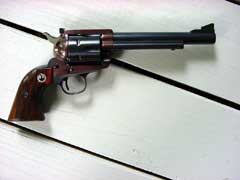
A true Type 1, with
the small serrated ejector rod button.
S/n 301, shipped 11/56.
Varnished smooth walnut grips and beautiful plum
colored frame.
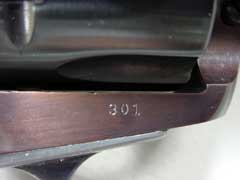
Close-up view of #301’s s/n.

S/n 301’s Type 1 small serrated square ejector rod
button and the long throw offset-slot ejector rod housing.

Framed advertisement from the 12/56 American
Rifleman magazine. “The Moment Of Truth” is my favorite .44 Flattop
advertisement !!
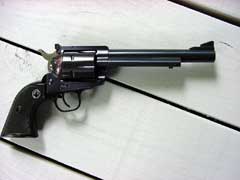
A very early Type 2, with the larger concave faced or
“dimpled” ejector rod button.
S/n 10, produced 12/56 but not shipped until 9/74!
Original checkered black hard rubber grips.
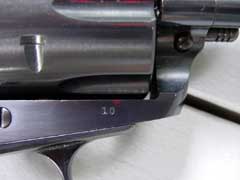
Close-up view of #10’s s/n.
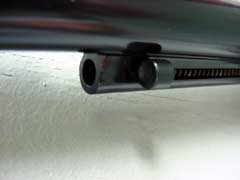
S/n 10’s Type 2 larger concave faced or
“dimpled” ejector rod button.
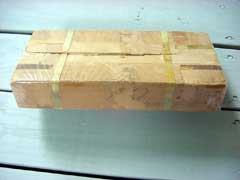
Cardboard “split top” shipping carton used for the
early Blackhawks. This
one is for s/n 10.
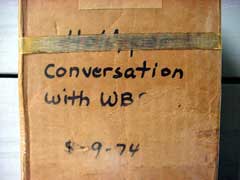
Bottom view of s/n 10’s shipping carton with a very
interesting hand written notation. It reads “Hold per
conversation with WBR, 8-9-74”.
Of course “WBR” stands for William (Bill)
Batterman Ruger!! The
note coincides with the gun’s late shipping date of
8/74.
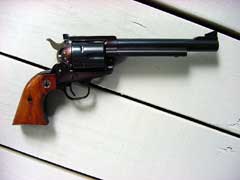
Early Type 2, with varnished walnut grip panels.
S/n 463, shipped 12/56.

Close-up view of #463’s s/n.
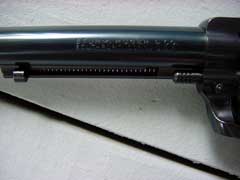
S/n 463’s Type 2 “dimpled” button, long throw
offset-slot housing, and non-collared cylinder base pin.
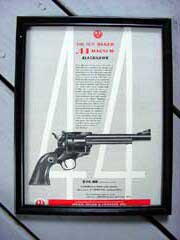
Framed first advertisement of the Blackhawk .44 found
in the 8/56 issue of the NRA’s American Rifleman magazine.
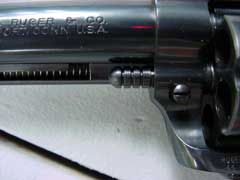
Scarce sub-group Type 2a, with its “wide land”
cylinder base pin tip.
Similar to a Single-Six base pin.
S/n 9302, shipped 5/58.
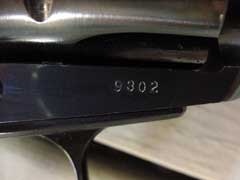
Close-up view of #9302’s s/n.

Early Type 3, with a “collared” cylinder base pin.
S/n 9680, shipped 5/58.
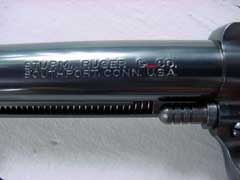
S/n 9680’s Type 3 “collared” cylinder base pin.

The three instruction and parts manuals used during
the .44 Flattop’s approximate six year life.
They are dated “Revised September 1, 1956”,
“Revised March 31, 1957”, and “Revised 9/1/59”.
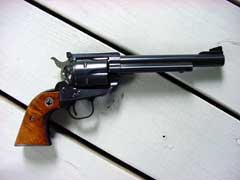
Example of the last major type, the Type 4. It has the straight slot ejector rod housing.
S/n 24462 was shipped 5/60.
It also has the larger flat
faced ejector rod button that was introduced fairly
early in the Type 4 production.
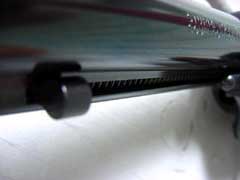
View of #24462’s straight slot housing and larger
flat faced button.
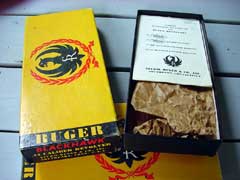
Open box for a 6-1/2” barrel gun.
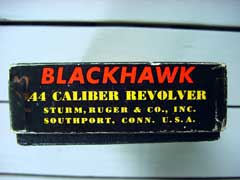
Common box end found on all but a very few of the
6-1/2” boxes. It
does not have the word Magnum, model number, or barrel
length.
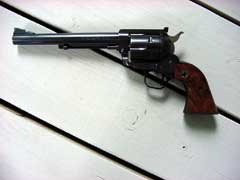
Rare Type 4 Flattop with a 7-1/2” barrel. S/n 22753, shipped 2/60.
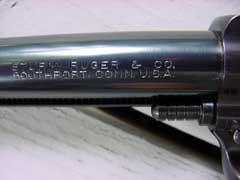
S/n 22753’s barrel address used on the majority of
the 6-1/2”, 7-1/2”
and 10” guns.
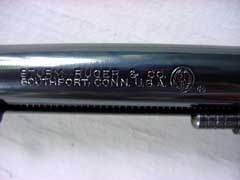
The rare “Eagle” barrel address found on a few
7-1/2” Flattops. This
is the same roll mark used on the Super Blackhawk
introduced in 11/59.
S/n 22391, shipped 2/60.

S/n 22391, 7-1/2” barrel “Eagle” gun.
While not in mint condition, it is a very rare and
desirable Flattop!!

Box end for the 7-1/2” barrel guns.

Box and cardboard shipping carton for 7-1/2” barrel
Flattop s/n 17608. This
shipper was originally white in color but has discolored
to an aged brownish look 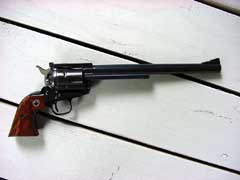
Rare Type 4 Flattop .44 with a 10” barrel. S/n 23517, shipped 4/60.
This gun is pictured on page 139 of John C.
Dugan’s great reference book, Know Your Ruger Single
Action Revolvers, 1953-63.
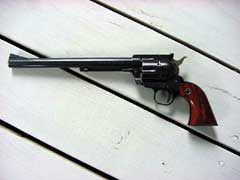
Left side view of the 10” barreled s/n 23517.

Top view of the 6-1/2”, 7-1/2” and 10” barrel
boxes for the Blackhawk .44s.
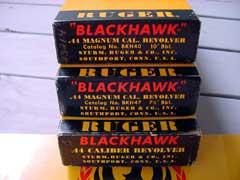
Box end view of the 6-1/2”, 7-1/2”, and 10”
barrel guns.
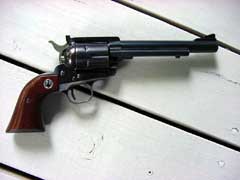
Very rare .44 Flattop with a XR3-RED grip frame.
S/n 28808, shipped 8/62.
Found in its original box with all its papers.
I also have s/n 28807 that has a XR3-RED grip
frame. It was
also shipped in 8/62.
Found years and 100s of miles apart, I believe that
they are both correct guns.
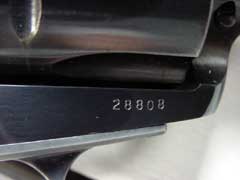
Close up view of #28808’s s/n.
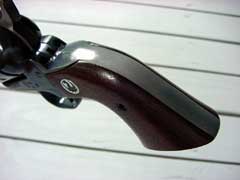
S/n 28808’s “graying” XR3-RED grip frame
backstrap. This
overall graying was seen on a lot of the early XR3-RED
grip frames. Note
the “varnished” XR3-RED grip panels on this gun - not
many were varnished, most were oiled.

This Flattop, s/n 29738, shipped 12/62, has a XR3-RED
grip frame and a non-fluted Super Blackhawk cylinder.
A very rare configuration, but there is no way to validate
that it came from the factory that way.
However, with the high s/n and ship date, it is
very possible that this gun is correct.
|
![]()